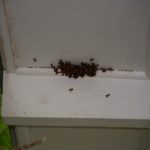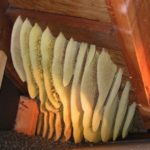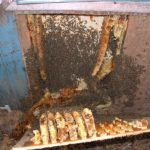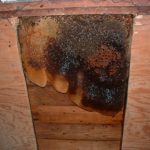Bee Proofing Your Buildings:
- Inspect outside walls and eves of your house and other buildings.
- Seal openings greater than one-eighth inch in diameter (⅛-inch) in walls, around chimneys, masonry, pluming, and any other openings.
- Install screens (⅛-inch hardware cloth) over rain spouts, vents, cavities of trees and fence posts, water meter, utility boxes, etc.
- From spring through fall inspect 1-2 times per week for bee activity around your house and yard.
What To Do If You Find Bees:
- Do not disturb a swarm or colony.
- Bees should not be allowed to live in a house or other structure. The longer a colony lives in a structure the more defensive they will become and the more costly removal and repair will become.
- Call a professional bee removal service or pest control operator.
- If no operators are listed in your area, see here
- If you do not live in Texas, contact your state beekeepers association for local assistance.
Potential Nesting Sites:
Bees will choose a nesting site in many places where people may disturb them. Nesting cavities may include: buckets, cans, empty boxes, old tires, or any container ranging in volume from as little as 2 to 10 gallons and more. Bees will also choose infrequently used vehicles, lumber piles, holes and cavities in fences, trees, even in the ground, in sheds, garages, and other outbuildings between walls or in the open, low decks or spaces under buildings.
REMOVE POTENTIAL NEST SITES
If you find bees on your property do not attempt to remove them yourself. Call a professional bee removal service or pest control operator.
If no operators are listed in your area, refer to the Texas County Bee Removal page for assistance. We do not refer or endorse specific businesses and, we do not provide removal services.
If you do not live in Texas, contact your state beekeepers’ association for local assistance.
Inspect Your Property:
- Listen for buzzing and look for bees entering or leaving the same area indicating a nest or swarm of bees.
- Carefully enter sheds and outbuildings where bees may nest.
- Examine work areas prior to using noisy power equipment such as lawn mowers, weed cutters, and chain saws.
- Examine areas for bees before tying up or penning pets and livestock.
- Watch and listen for bees when outdoors.
- Never disturb a swarm or colony of bees – contact a bee removal service or pest control company.
- Teach children to be cautious around and respectful to all bees.
- If you know you are allergic to bee stings check with your doctor about a sting kit.
- Have a bee safety plan in place for your family.





